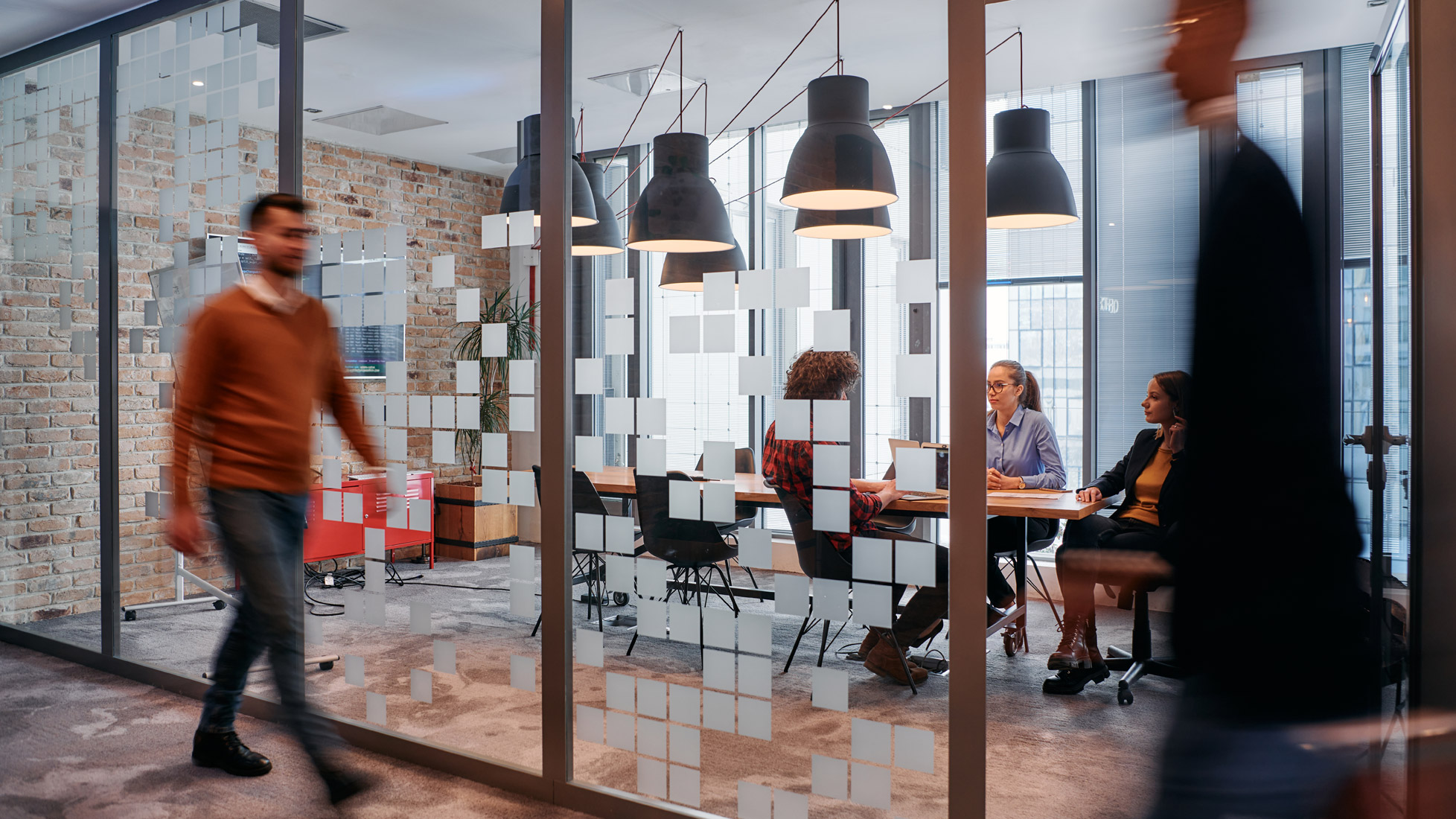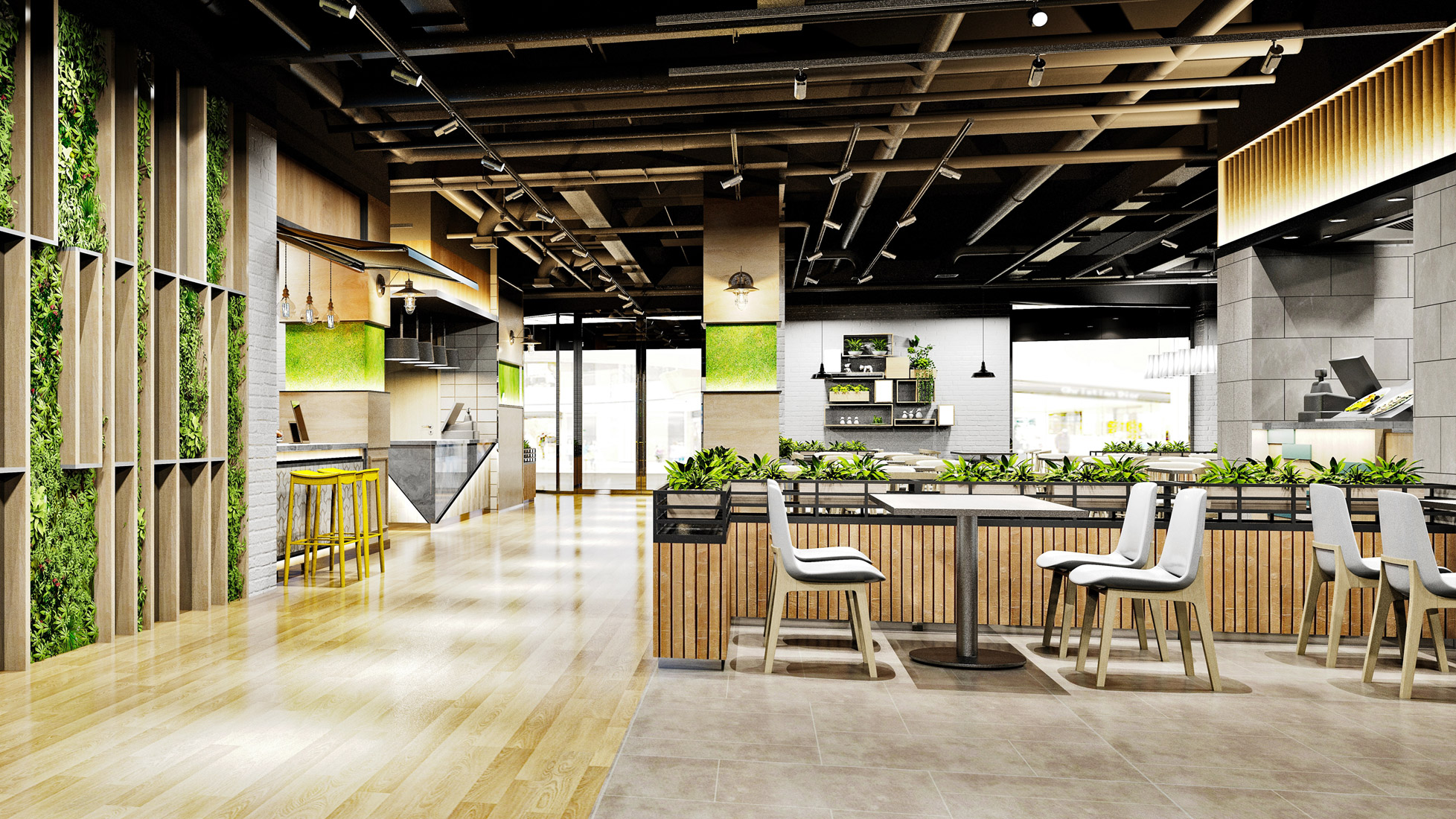As office space continues to evolve office design and refurbishment trends will continue to develop to meet Kent and London office space business and staff needs in 2025. Offices have had to change to become increasingly flexible, inclusive and sustainable. Here are some of the key office design and refurbishment trends for 2025.
Company Culture and Branding
Businesses are looking to Integrate company culture and branding into their office designs to help to showcase their company identity, core values and thinking. Personalising an office space can take it from being a business location where staff go to work to the heart of a business that represents a company’s identity and vision.
Reflecting the company culture and brand can help employees take pride in their office space and create a welcoming environment which helps to foster a sense of satisfaction, belonging and purpose leading to job satisfaction, increased levels of engagement and good health and wellbeing. Where staff feel valued innovation, motivation and productivity levels are also likely to be higher. Where a company is seen to have a positive culture, it can help to attract new staff as new hires often consider how a company presents itself when they are looking for to move jobs.
When an office space reflects a strong company culture it can also positively impact clients and site visitors in how they perceive a company, leading to strong brand recognition and enhanced reputation which can help to inspire confidence in customers which will keep them coming back and making them a preferred supplier of services and products.
Incorporating a company logo, custom colour palette that complements the branding, custom signage, mission statement and achievements or office graffiti, murals or artwork that reflect the culture of a company are just a few examples of ways of utilising culture and branding in office design and refurbishment.
Colour Palette Changes
Colours will play a powerful role in the design of office space in 2025. Colour has a major role in how it influences mood, creativity and productivity. We know colour can have an emotional and psychological impact on mood on a subconscious level through research e.g. Naoyuki Osaka’s article “Emotional neuroaesthetics of color experience: Views from single, paired, and complex color combinations” which monitored the brain activity of participants while they were viewing colour presentations. They found that when something beautiful is observed it results in an activation of the orbitofrontal cortex and the medial pre-frontal cortex which increases pleasure/reward and removes aversive stimuli and translates it into an emotional like or dislike response e.g., participants found harmonious colours to be a source of comfort.
Gone are the days of bland colour schemes or colour palettes that utilise garish colours instead colours are trending towards more natural, softer colour schemes. Having the right colours around can soothe you and have a calming effect which can help you to relax, or they can be an excellent way to lift spirits and combat stress and promote focus. Other colours can be restful and diffuse anxiety.
Colour can also be used to “zone” areas within an office space to reflect the purpose of the space e.g. a blue zone for quiet, focussed work; blue accents to help with concentration and productivity, greens can promote calm, reduce fatigue and boost staff wellbeing; neutral browns and beiges can create a warm atmosphere and help staff feel grounded. Utilising browns in boardrooms can imbue a sophistication. Yellow can lift your spirits and confidence and is often linked to positive emotions like happiness, optimism and excitement. It’s commonly used in the creative industry.
Inclusive Design
Office design and refurbishment in 2025 needs to be inclusive. It’s important to create an office space that everyone can use ensuring accessibility for all employees. As we become more aware of the different and diverse needs of staff, we need to look at ways to design office space to make accommodations for sensory, cognitive, and neurodiverse requirements as well as physical disabilities.
Various aspects need to be addressed to provide an inclusive workspace. Sensory considerations should include areas with varied lighting or where the light level can be fully controlled to provide a space with lowered light levels. Noise levels can also be problematic so quiet zones where there are few or no distractions or private office spaces should be considered. To meet disabled staff needs offices can be designed with wider doors, wheelchair-accessible layouts e.g. wider spaces between desks; disabled, height adjustable desks; ergonomic chairs, grab rails in washrooms, height adjustable kitchen sink units and work tops, lower washroom basins, access ramps and railings or a lift, cable management racks, desk mounted sockets and adjustable monitor arms.
Including assistive technologies like screen readers, braille displays, magnifiers, audio descriptions, speech to text software or voice activated systems along with clear signage throughout the office building and high contrast visuals will provide an accessible, inclusive working environment.
Making an office that is accessible to everyone, and which accommodates a range of diverse needs, brings with a range of benefits. One of the main benefits is staff recruitment which is influenced by how diverse a workforce is. A survey by Glassdoor found that more than 3 in 4 employees and job seekers report a diverse workforce is an important factor when evaluating companies and job offers. McKinsey and Company found that companies with more diverse workforces perform better financially. Cloverpop produced a white paper which found that “diverse teams make better decisions 87% of the time, drive decision-making twice as fast with half the meetings and improve decision team results by 60%.”
Hybrid Working
In 2019, only 4.7% of UK employees worked from home. The pandemic forced a change in working practices when many companies had to sens staff home to work. Once businesses reopened working from home and hybrid working (with varying numbers of office and home days) continued. In 2020 the Office for National Statistics (ONS) found that “46.6% of people in employment [still] did some work at home.”
The Chartered Institute of Personnel and Development (CIPD’s) “Flexible working: the business case” explains why hybrid working is good for businesses and staff. According to the CIPD in 2024 41% of employers were still allowing hybrid working with formalised policies in place. Leesman’s “Hybrid Future” found 91% of employees like hybrid working.
Given that hybrid working is likely to continue for some time office design and refurbishment plans need to strike a balance between those employees who want to partly work from home, depending on the type of work they do, and those staff who prefer to come into the office every day.
Flexibility
If we’ve learned anything from the pandemic it’s that in 2025 offices need to be designed to be adaptable, to be able to change to different sets of circumstances as easily as possible.
Office furniture needs to be modular, adaptable, multifunctional and movable, easy to take down and move around as required to provide much needed flexibility. Designs need to utilise multipurpose screen dividers e.g. living walls and plant wall dividers, storage walls, flexible partitioning and “write on” walls that can be easily moved as required.
Incorporating IT
Given the need for flexibility and the importance of being able to provide space and a workplace for staff who come into the office technology is important. Meeting room, collaboration areas and a workspace booking system will have an important role to play in ensuring office space is never overbooked, proving the reliability and security that staff need to know that there will always be space for them when they choose to work from the office.
Staff must also be able to work and to connect no matter whether they are in the office, away on business or at home. Incorporating the appropriate video conferencing technology in the office design will be key to maintaining good communication and collaboration with staff inside and outside the office.
Good Wi-Fi coverage is important to allow staff to work and connect no matter what part of the office space they are working in. Having portable power and power integrated furniture will also mean staff can “plug in” and start working wherever and whenever they need to.
Zoning
Zoning is gaining popularity in office design and is becoming essential in modern office spaces.
When it comes to designing your office one of the first decisions to be made is how to lay out your office space. There are a number of factors to consider including how the design can make it easier for users to move through their day by designing a dynamic and flexible office space that encourages movement, wellbeing, collaboration and socialisation. By going beyond providing functional workstations, an office space can provide an environment that allows staff to seamlessly transition from task to task and between work and breaks.
It continues to be important to provide private, quiet zones for carrying out sensitive work or work that requires deep focus alongside zones that allow for collaboration where staff can come together to work and brainstorm together. A workplace survey carried out by IPSOS of over 10,500 workers across Europe, North America and Asia confirms that “insufficient privacy in the workplace is an issue throughout the world.” The survey shows that “being able to concentrate, work in teams without being interrupted or choose where to work based on the task are frequently unmet needs.” Finding the right balance between privacy and collaboration is key. We also know that breakout areas play a vital role in staff health and wellbeing as they provide a space that allows employees to get away from their workstation, “switch off” from work and relax for a few moments. Breakout areas can also act as social areas for staff to come together informally.
In essence it’s about incorporating different types of “work spaces” into your office design to allow staff to work alone in private, work as part of a team, collaborate with others in small or large groups and to be able to break away from work when they need some downtime.
Multi-Use Spaces
The move of office space towards flexibility, hybrid working practices and different work styles in 2025 has increased the demand for multi-use workspaces that can fulfil a number of varying demands and meet multiple needs. To this end it’s important to ensure layouts can be reconfigured by utilising moveable or folding partitions and other flexible, mobile furniture e.g. adaptable furniture such as modular desk systems and flexible workstations that can be expanded and modular seating areas these can be rearranged to suit multiple business requirements.
The built-in flexibility of these systems can provide space that supports every work style and provides space for focussed individual working, collaborative working for teams to come together as well as space to allow staff to break away and relax. Adaptable spaces can be changed or modified to suit the changing needs within a business.
It’s also important to remember that where office space will be fulfilling multiple purposes having the right technology available within that space will be vital. Having easy access to charging points, power outlets and docking stations will make it easier for staff to move around as required.
Using space to provide multi-functional purposes can also provide for potential growth e.g. a comfortable seating area can act as a break out area for staff, a client waiting area or a collaboration space. This flexibility enables your business to utilise the same space for multiple purposes, transitioning between business needs all within the one workspace.
Where spaces may be in demand booking systems will be a must to ensure seats, desks and meeting room bookings don’t clash and staff can reliably book a space and know it will be available to them when required.
Focus On Health and Wellbeing
We know through research and surveys that office health and wellbeing is a priority and an essential part of ensuring job satisfaction, increasing productivity, lowering stress and anxiety and reducing absenteeism.
There are a number of office design and refurbishment ideas that will continue to be important in 2025 and beyond when it comes to employee health and wellbeing. Using natural light wherever possible in an office space can significantly impact mood and physical and mental health and wellbeing. Natural light also “helps our bodies produce Vitamin D, helps us to focus, enables us to get more done, and even makes us happier.” Research has also shown that a lack of light can lead to Seasonal Affective Disorder (SAD) as well as “disturbed sleep patterns which in turn can result in persistent low mood, depression, irritability, bipolar disorder, diabetes and stress.”
The use of colour within an office has been shown to have psychological, emotional, and physical effects on mood on a subconscious level. As we mentioned previously colours can have a calming effect and help you relax; other colours can be stimulating. Having the right colours around you can be an excellent way to reduce stress. It’s therefore important to think about the colour scheme being used in your office and how it might impact mood and stress levels.
Integrating plants and greenery into office design, known as biophilic design, isn’t just for aesthetics, it impacts our health and wellbeing, reduces stress levels, increases our attention span, improves memory and learning, increases creativity, and reduces presenteeism and absenteeism. The Green Plants For Green Buildings report “The Global Impact of Biophilic Design in the Workplace” based on a survey of 7600 employees from 16 countries found that “nature and biophilic design impact our well-being, productivity and creativity at work, [and] are significant.” The report found that “workers’ productivity depends on the environment they are in” and “perceptions of well-being can increase by up to 15% when people work in surroundings that incorporate natural elements, providing that connection to nature, in contrast to those who have no contact to nature in their workplace.”
The availability of office breakout areas play a vital role in office health and wellbeing. They provide a space which can be used to get away from the hustle and bustle of a busy office to take a break and relax. Being able to “switch off” from work and refresh the mind for a few moments is incredibly valuable.
An office’s air quality, temperature and humidity can impact health and wellbeing. By ensuring office air quality, temperature and humidity are regulated and monitored businesses can ensure a healthier working environment which can make for a happier and healthier office. Designing an office space is the perfect time to look at installing an air conditioning system or upgrading an old system. Other office factors like noise can be a major workplace stressor if not properly considered and planned for during an office design. Suspended and acoustic ceiling tiles can be effective in absorbing noise. Acoustic screens, partition walls, panels and dividers can also be used as noise barriers to absorb unwanted noise and prevent it from passing from office to office.
Encouraging Movement
Being inactive can lead to reduced metabolism, disrupted sugar levels and increased insulin and blood pressure levels which in turn leads to an increased risk of heart disease, diabetes, obesity, some types of cancer, depression as well as back pain and muscular problems
Office design that encourages movement has been gaining in popularity again since the 1970s when there was an increased focus on occupational health and safety due to the Health and Safety at Work Act of 1974 legislation.
Given that on average office-based workers spend 8.9 hours each day sitting in the office. Banner say that “the typical office worker will sit at their desk for over 1,300 hours this year, 10,000 hours just eight years into their career, and 53,000 hours by the time they retire.” Encouraging movement can only be a good thing. In fact according to Medical Xpress “In the UK sedentary behaviors are known to contribute to over £700 million in NHS costs and were responsible for 69,276 deaths in 2016.” Embracing zoning and multi-use spaces or changing the office layout to be activity based, so that instead of employees having a fixed seat or space in the office they are free to move around to different work areas depending on the tasks they are performing can have a fundamental impact on staff health and wellbeing.
When it comes to furniture, sit stand desks are also becoming more prevalent, helping to encourage staff to stand rather than to sit throughout the work day. Ensuring your office is designed to be ergonomic can help to combat work-related musculoskeletal disorders and other office.
By partnering with an office design expert businesses can identify the right office design for their company and which, if any, of the latest trends will best suit their needs.
JBH Refurbishments, Experts In Office Design and Refurbishment
JBH Refurbishments are a cat a and cat b fit out contractor and have over 30+ years experience in Kent and London office design, office refurbishments and fit outs. We can provide the right expertise for your Kent or London office refurbishment. We understand what’s required to carry out an office refurbishment.
From your brief, to putting together a project plan, to developing your office design and layout to delivering your office fit out JBH Refurbishments will provide the right expertise for your project providing peace of mind. You can contact us on 0333 207 0339 or via our contact page or by calling us on 0333 207 0339 today for a free on-site consultation.







